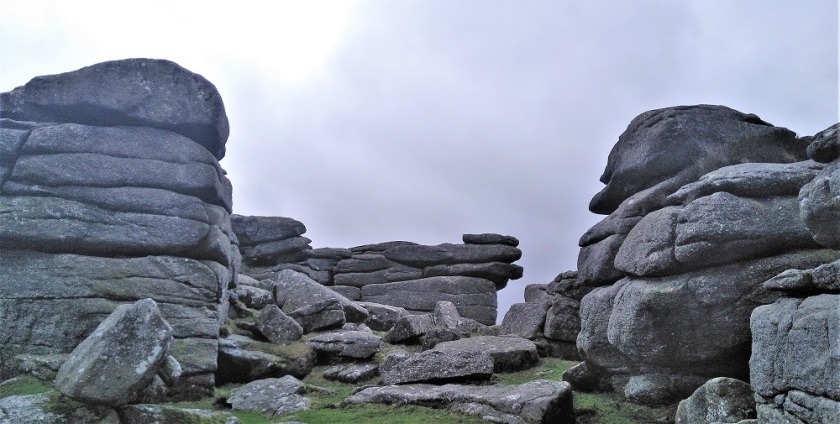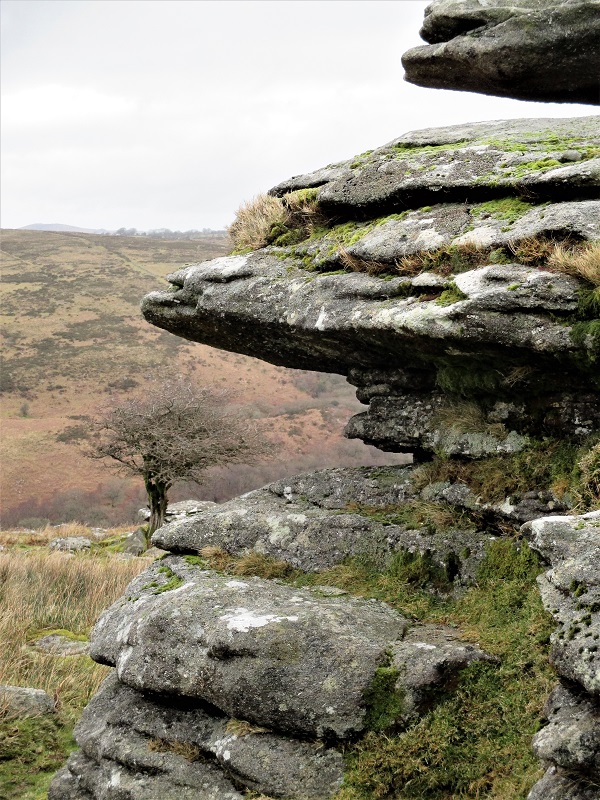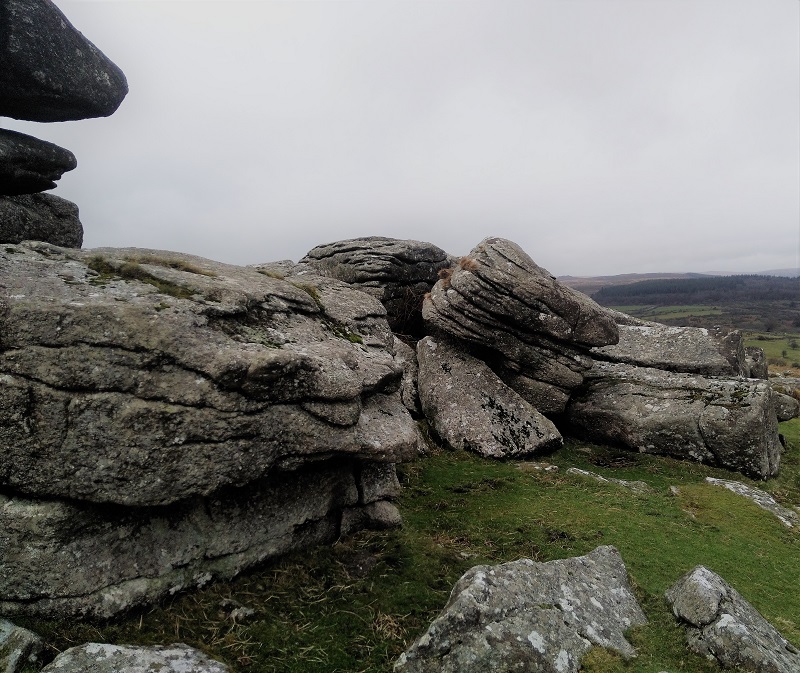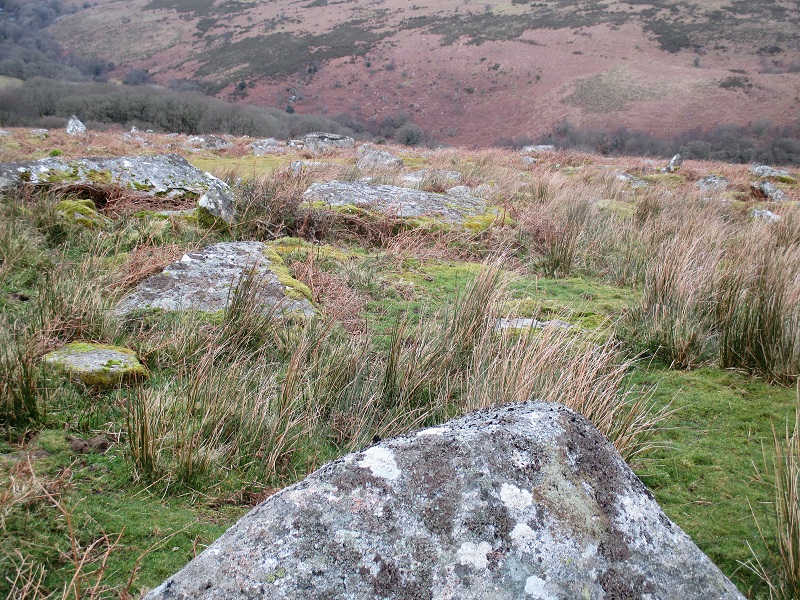Bogs … prisons … tors …
It is said that no matter where you look on Dartmoor, you can’t help but have a tor in view. Frustrating then, that I managed to miss all of them in the wider landscape shots I took. But we did spend some time getting acquainted with one tor in particular.

Tim Sandles, compiler of the extensive Legendary Dartmoor site, suggests that the word originates from the Celtic twr, which means ‘tower’. The definition of a tor, he tells me is: “a prominent outcrop of rock that can occur at any point between valley floor and hilltop”. There are almost 150 tors on Dartmoor. Tim offers a comprehensive account here of how they have been formed over the millennia.
My old friend Sabine Baring-Gould devotes chapter two of A Book of Dartmoor to tors – putting them second only to bogs.
Enough said.
He quotes from his colleague, Collier, addressing the Devonshire Association in 1875:
The tors – Nature’s towers – are huge masses of granite on the top of the hills, which are not high enough to be called mountains, piled one upon another in Nature’s own fantastic way. There may be a tor, or a group of tors, crowning an eminence, but the effect, either near or afar, is to give the hilltop a grand and imposing look. These large blocks of granite, poised on one another, some appearing as if they must fall, others piled with curious regularity – considering they are Nature’s work – are the prominent features of a Dartmoor landscape, and wild as parts of Dartmoor are, the tors add a notable picturesque effect to the scene.
 Having taken to the roads on foot, we next took to the roads by car. We drove that way and this, twisting and turning along unused roads with no particular destination in mind. Bernie had a fancy to visit Hexworthy, perhaps because of its evocative name. It was remote and atmospheric with a wonderful old bridge that I later learned was a location for the filming of War Horse. Climbing out of Hexworthy we were atop the moor and right there beside the road was a tor. And next to the tor was a car park. Most things may be closed here in January, but some things are at their best in these inclement months. The place was deserted, and we could breathe in the whistling air and immerse ourselves in the passing of eons.
Having taken to the roads on foot, we next took to the roads by car. We drove that way and this, twisting and turning along unused roads with no particular destination in mind. Bernie had a fancy to visit Hexworthy, perhaps because of its evocative name. It was remote and atmospheric with a wonderful old bridge that I later learned was a location for the filming of War Horse. Climbing out of Hexworthy we were atop the moor and right there beside the road was a tor. And next to the tor was a car park. Most things may be closed here in January, but some things are at their best in these inclement months. The place was deserted, and we could breathe in the whistling air and immerse ourselves in the passing of eons.

At the time we had no idea which tor we stood beside. We were not encumbered by knowledge; we had only to absorb the atmosphere. The wind was sharp, yet the silence was biting. The views down into the valley were sweeping, yet the intimacy – the immediacy – of the grey granite stacks was compelling. What history these rocks will have witnessed. How many seasons of harsh winters and misty autumns, crisp vibrant springs and far-seeing summers will have passed alongside and between these crags. I thought of the people who will have passed this way too: from the Neolithic and Bronze Ages to the current armed forces who sometimes use this land for training purposes. And between the two – generations who forged a living in these beautiful but inhospitable climes. Tinners, peat cutters, farmers and no doubt the occasional Anglican priest, passing back and forth along tracks worn deep by the countless hooves of ponies, sheep and cattle and the rhythmic tramp of human feet.

On the sides of the tors are what are locally termed ‘clitters’ or ‘clatters’ (Welsh clechr), consisting of a vast quantity of stone strewn in streams from the tors, spreading out fan-like on the slopes. These are the wreckage of the tor when far higher than it is now, i.e. of the harder portions that have not been dissolved and swept away.
It doesn’t surprise me that so many legends and tales have formed against the backdrop of Dartmoor. Centuries back, these mysterious formations will have defied, yet demanded explanation. Sometimes stories are necessary for quieting the soul. This, and more, filled my mind with formless thoughts and impressions as I wandered cautiously, camera in hand. Perhaps it was this sense of the past, and the stories to be told if only the stones could speak, that led me to relax into the place. So much so, that before I knew it I was on the ground, one arm and leg bent under me, taking in a worm’s eye view of the rocks and wondering how I’d gone from upright to prone without noticing. Luckily at the time I was on the grass rather than on the granite. I can confirm that the springy, sodden sedges are very slippery, and are indeed covering a very high-water table in January – but consequently form a suitably soft, if extremely damp, landing place. At least there were no witnesses to my downfall so not even my pride was hurt. And thankfully, I didn’t recover my wits only to see my camera ignominiously sinking into the mire…
This, and more, filled my mind with formless thoughts and impressions as I wandered cautiously, camera in hand. Perhaps it was this sense of the past, and the stories to be told if only the stones could speak, that led me to relax into the place. So much so, that before I knew it I was on the ground, one arm and leg bent under me, taking in a worm’s eye view of the rocks and wondering how I’d gone from upright to prone without noticing. Luckily at the time I was on the grass rather than on the granite. I can confirm that the springy, sodden sedges are very slippery, and are indeed covering a very high-water table in January – but consequently form a suitably soft, if extremely damp, landing place. At least there were no witnesses to my downfall so not even my pride was hurt. And thankfully, I didn’t recover my wits only to see my camera ignominiously sinking into the mire…
Tim Sandles on clitters: “Personally speaking they are one of the most unpleasant things to walk through and an accident just waiting to happen.” It’s not just me then!

Back at the hotel, distracting myself from how I was going to get the mud out of the almost-new coat I’d been wearing, I established that we had visited Combestone Tor. As well as adding some geological detail, Tim Sandles mentions how popular the tor is in the tourist months because it’s so accessible. As tors go, Combestone is not one of the highest or most dramatic and I’m so pleased we saw it as we did – isolated and commanding.
Tim also tells an interesting little tale about an irritating ‘tourist’ he met there. Perhaps the stories of magic and mystery still hold some truth in them…


Beautiful! You are quite the hypnotist with your words. Add to that, the aura of the tors, almost a voodoo.
LikeLiked by 1 person
There was a definite sense of the past echoing around those rocks, Uma. Lonely and almost sinister. I imagine it feels quite different in the warmer months, when crowded with people.
LikeLiked by 1 person
Your tors hit the same kind of spot as our Brimham Rocks (https://en.wikipedia.org/wiki/Brimham_Rocks) though ours are harder to explore in truly lonely conditions, as you have. I’ve never visited Dartmoor. After your evocative post, this has become another one for the wish-list.
LikeLiked by 1 person
I was thinking about you and Yorkshire while wittering on about Dartmoor, Margaret. There are of course, so many places beyond the W Country that have the same feel and/or the same phenomena. Brimham Rocks look wonderful, and I suspect that swathes of the Yorkshire Moors and the Pennines are more rugged, more isolated and certainly enjoy (endure?) a harsher climate than down here.
I find myself stumbling across various signposts to Nidderdale at the moment – I’m reading The January Man by Christopher Somerville, taking each chapter in its relevant month. And March was Nidderdale. One day I’ll get up there 🙂
LikeLike
Beautifully written musings. Very pleased you and your camera were both unharmed. In the New Forest boggy bits I often had my shoes sucked off my feet
LikeLiked by 1 person
Nasty! I’m thinking of you paddling home in soggy shoes now, Derrick. Assuming you were able to reover them that is!
LikeLiked by 1 person
One disappeared completely. Fortunately I was able to fish it out before I had the ignominy of ringing Jackie to come and fetch me 🙂
LikeLiked by 1 person
Oh dear! I know I shouldn’t be chuckling…. but I am! Glad you were saved from making that call, Derrick!
LikeLiked by 1 person
🙂 🙂
LikeLike
That gray day seems perfect for your visit–adds to the mood so well. I can’t remember which tors we explored but I think they were in Bodmin Moor . . .
LikeLiked by 1 person
Bodmin is our ‘local’ moor. For some reason – probably because it’s on the doorstep, we have yet to walk up there. One day, hopefully soon!
LikeLike
I understand–I lived, for 20-plus years, a few miles from Niagara Falls and hardly ever went there. . . .
LikeLiked by 1 person
I love your stories, Sandra, you create such a wonderful atmosphere with your words!
LikeLiked by 1 person
Marina, that’s a lovely thing to know, coming from you – she, who weaves magic in poetry 🙂 Thank you!
LikeLike
“Centuries back, these mysterious formations will have defied, yet demanded explanation.”
Very true, and yet I’m always a little sorry that people have found explanations. Science is wonderful, but sometimes not knowing allows the imagination more scope. Like the Giant’s Causeway – it lost a little of its magic for me when I became too old and wise to believe in giants…
LikeLiked by 1 person
Totally agree. It’s why I was happy that we knew nothing – not even the name of the tor – whilst we were there. Those stories could be heard above the ‘scientific’ explanations 🙂
LikeLiked by 1 person